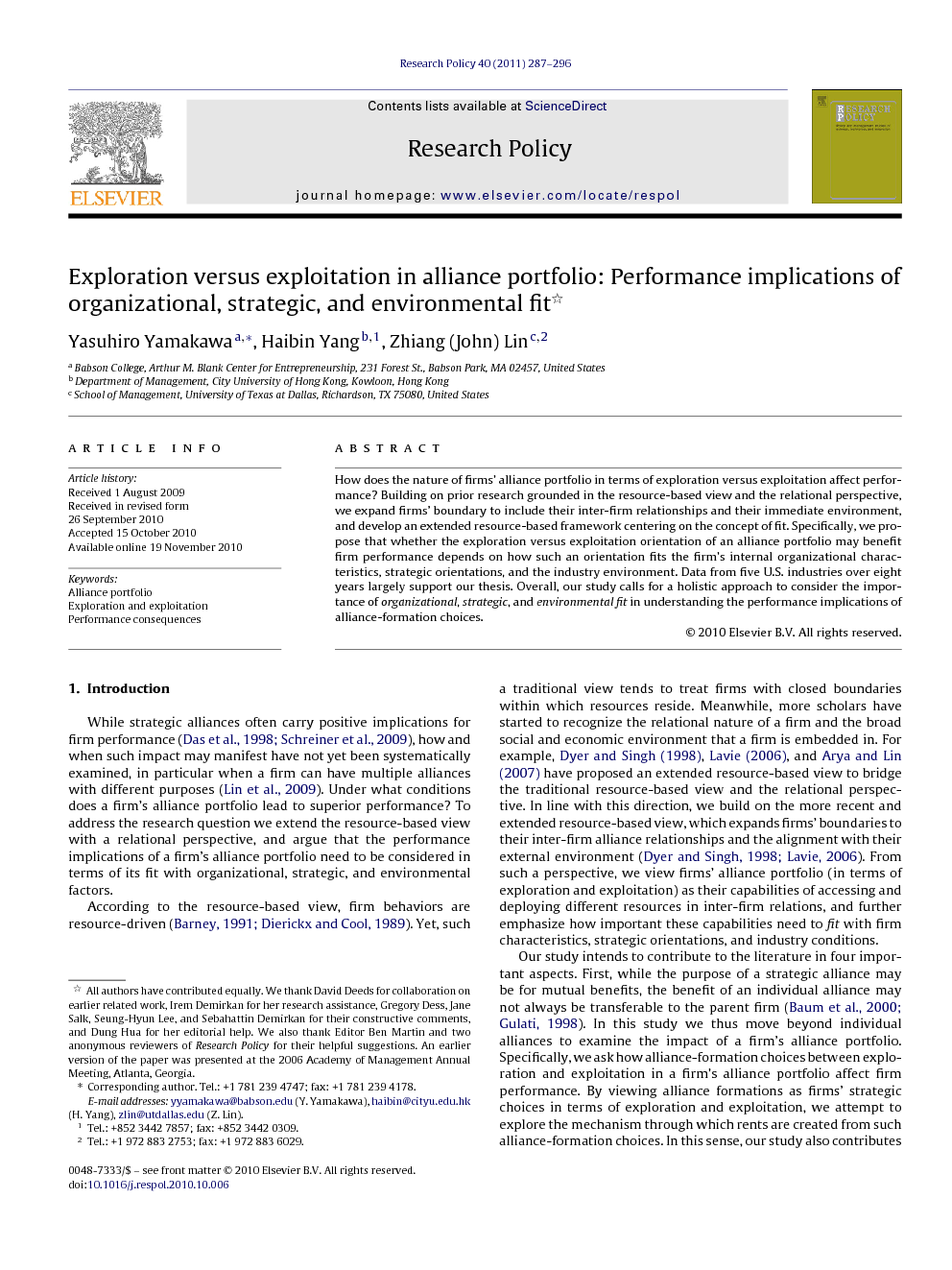How does the nature of firms’ alliance portfolio in terms of exploration versus exploitation affect performance? Building on prior research grounded in the resource-based view and the relational perspective, we expand firms’ boundary to include their inter-firm relationships and their immediate environment, and develop an extended resource-based framework centering on the concept of fit. Specifically, we propose that whether the exploration versus exploitation orientation of an alliance portfolio may benefit firm performance depends on how such an orientation fits the firm's internal organizational characteristics, strategic orientations, and the industry environment. Data from five U.S. industries over eight years largely support our thesis. Overall, our study calls for a holistic approach to consider the importance of organizational, strategic, and environmental fit in understanding the performance implications of alliance-formation choices.
While strategic alliances often carry positive implications for firm performance (Das et al., 1998 and Schreiner et al., 2009), how and when such impact may manifest have not yet been systematically examined, in particular when a firm can have multiple alliances with different purposes (Lin et al., 2009). Under what conditions does a firm's alliance portfolio lead to superior performance? To address the research question we extend the resource-based view with a relational perspective, and argue that the performance implications of a firm's alliance portfolio need to be considered in terms of its fit with organizational, strategic, and environmental factors.
According to the resource-based view, firm behaviors are resource-driven (Barney, 1991 and Dierickx and Cool, 1989). Yet, such a traditional view tends to treat firms with closed boundaries within which resources reside. Meanwhile, more scholars have started to recognize the relational nature of a firm and the broad social and economic environment that a firm is embedded in. For example, Dyer and Singh (1998), Lavie (2006), and Arya and Lin (2007) have proposed an extended resource-based view to bridge the traditional resource-based view and the relational perspective. In line with this direction, we build on the more recent and extended resource-based view, which expands firms’ boundaries to their inter-firm alliance relationships and the alignment with their external environment (Dyer and Singh, 1998 and Lavie, 2006). From such a perspective, we view firms’ alliance portfolio (in terms of exploration and exploitation) as their capabilities of accessing and deploying different resources in inter-firm relations, and further emphasize how important these capabilities need to fit with firm characteristics, strategic orientations, and industry conditions.
Our study intends to contribute to the literature in four important aspects. First, while the purpose of a strategic alliance may be for mutual benefits, the benefit of an individual alliance may not always be transferable to the parent firm (Baum et al., 2000 and Gulati, 1998). In this study we thus move beyond individual alliances to examine the impact of a firm's alliance portfolio. Specifically, we ask how alliance-formation choices between exploration and exploitation in a firm's alliance portfolio affect firm performance. By viewing alliance formations as firms’ strategic choices in terms of exploration and exploitation, we attempt to explore the mechanism through which rents are created from such alliance-formation choices. In this sense, our study also contributes to the burgeoning literature that delineates the boundary of the exploration–exploitation paradigm.
Second, we clarify the relationships among firms’ alliance purpose, competitive strategy, and performance. This study builds on the recent stream of research (e.g., Ruiz-Ortega and Garcia-Villaverde, 2008 and Vorhies et al., 2009) that extends the resource-based view through meshing it with other perspectives (e.g., competitive strategy, relational perspective). We further advance the extended resource-based view (Dyer and Singh, 1998 and Lavie, 2006) by applying it to the study of strategic alliances while considering firms as having open boundaries with inter-firm alliance relations.
Third, in implementing the extended resource-based view, we highlight the importance of fit – organizational, strategic, and environmental fit that affects firm performance – as suggested in other studies (e.g., Kratzer et al., 2008). Specifically, we explore whether a firm's alliance portfolio leads to superior performance when its resources are combined effectively with appropriate organizational characteristics, strategic orientations and environmental circumstances (Dickson and Weaver, 1997). Our approach not only addresses endogeneity issues commonly confronted by prior studies in this area, but also examines the impact of fit among internal and external boundary conditions that affect firm performance. To truly understand strategic alliances it is as important as exploring the antecedents to examine the consequences of a firm's alliance-formation choices and its boundary conditions ( Lin et al., 2009).
Fourth, we attempt to make a contribution to the literature by empirically testing our model in a multi-industry setting. While prior research has generally focused on one industry (Park et al., 2002 and Rothaermel, 2001a), we employ a multi-industry context to increase heterogeneity within our sample. Overall, our study extends the resource-based framework to include not only firm characteristics but also their inter-firm relations and their immediate environment when investigating the role of a firm's alliance portfolio on firm performance (Lavie, 2006 and Rothaermel, 2001b).
Our study has highlighted the importance of using an extended resource-based view to examine the relationship between a firm's alliance-formation choices and its performance. Our findings suggest that performance implications of a firm's alliance portfolio depend on organizational, strategic, and environmental fit. Specifically, it is critical to consider the level of fit among alliance formation (exploration/exploitation), firm age, firm strategy (cost leadership/differentiation), and industry condition (industry growth) so as to gain a better understanding of firm performance.


